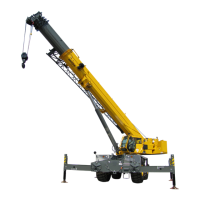NBT60L OPERATOR MANUAL CONTROLS AND OPERATING PROCEDURES
NATIONAL CRANE Published 09-06-2019 Control # 691-01 3-27
determine to approximate height to which the load can
be lifted.
The load chart contains the lifting capacities of the crane in
all allowable lifting configurations. The information is
presented in several parts, which include various outrigger
configuration for retracted span, partial span(s), and fully
extended spans, over rear operation, and several optional
counterweight configurations for the NBT60L of cranes.
Each part contains the load chart, range diagram, and hoist
data sheet. In the examples shown here, the information for
the outriggers fully extended is used.
NOTE: The range diagram and hoist data chart shown in
this manual are examples only. See the load charts
attached to the crane for actual values.
• The load chart is used to determine the weight limit of
the load based on the load radius and boom angle. All
lifting devices must be included when determining the
weight of the load.
• The range diagram (Figure 3-19) shows the operating
radius and the height from horizontal of the unloaded
boom.
• The hoist data chart (Figure 3-20) shows hoist capacity
and multi-part line reeving. The correct reeving for all
loads listed in the load chart is also shown.
Before you can determine the crane configuration you need
to know:
• the weight of the load to be lifted.
• the lifting devices needed.
• the height of the lift.
• the horizontal distance from the center of rotation (load
radius) to where the load is to be placed.
To determine the safe operating parameters you need to:
1. Get the weight of the load to be lifted.
2. Approximate the load radius. This is the horizontal
distance from crane center of rotation to where the
payload is to be placed.
3. Determine the lifting devices and hook block reeving
using the hoist data chart.
4. Calculate the combined weight of the lifting devices and
the load to be lifted.
5. Determine the boom angle and length from the range
diagram using the height and load radius of the lift.
6. In the load chart, take the load radius and boom angle/
length column over to the weight column and check the
weight. If the weight is between two values, use the
lower value.
LIFTING THE LOAD
The following general guidelines outline the proper
procedure for making a lift after the crane has been properly
set up.
1. Position the crane in the work area and set the
outriggers. See Outrigger Setup, page 4-1.
2. Program the RCL. For more information, see “RCL
Setup” on page 7-8. Use the load chart to estimate the
values.
3. Position the boom nose over the load. Do not try and
drag the load with the boom or hoist.
4. Perform the lift. Use light variable movements of the
controls when moving the load to avoid sudden stops.
5. Retract and lower the boom after the lift is complete.
SHUT DOWN AND PREPARATION FOR
ROAD TRAVEL
1. Ensure the jib, if so equipped, is properly stowed and
secured or removed from crane.
CAUTION
Disengage PTO for travel, including within a job site.
Disengage the hydraulic pumps for extended traveling,
cold weather starting, or engine checks.
Check cold tire pressure prior to extended travel. Refer to
tire inflation decal on crane.
CAUTION
Machine Damage Hazard!
Do not travel with an empty hook in a position where it can
swing freely. Either remove the hook block and/or
downhaul weight from the hoist rope(s) and stow securely
or make sure the hook block or downhaul weight is
properly secured to the tie down provided for that
purpose.
Fully retract the outrigger jacks and properly store the
pads.
WARNING
Do not travel with jib extended to prevent damage to
equipment.
Failure to comply with these instructions may cause death
or serious injury.

